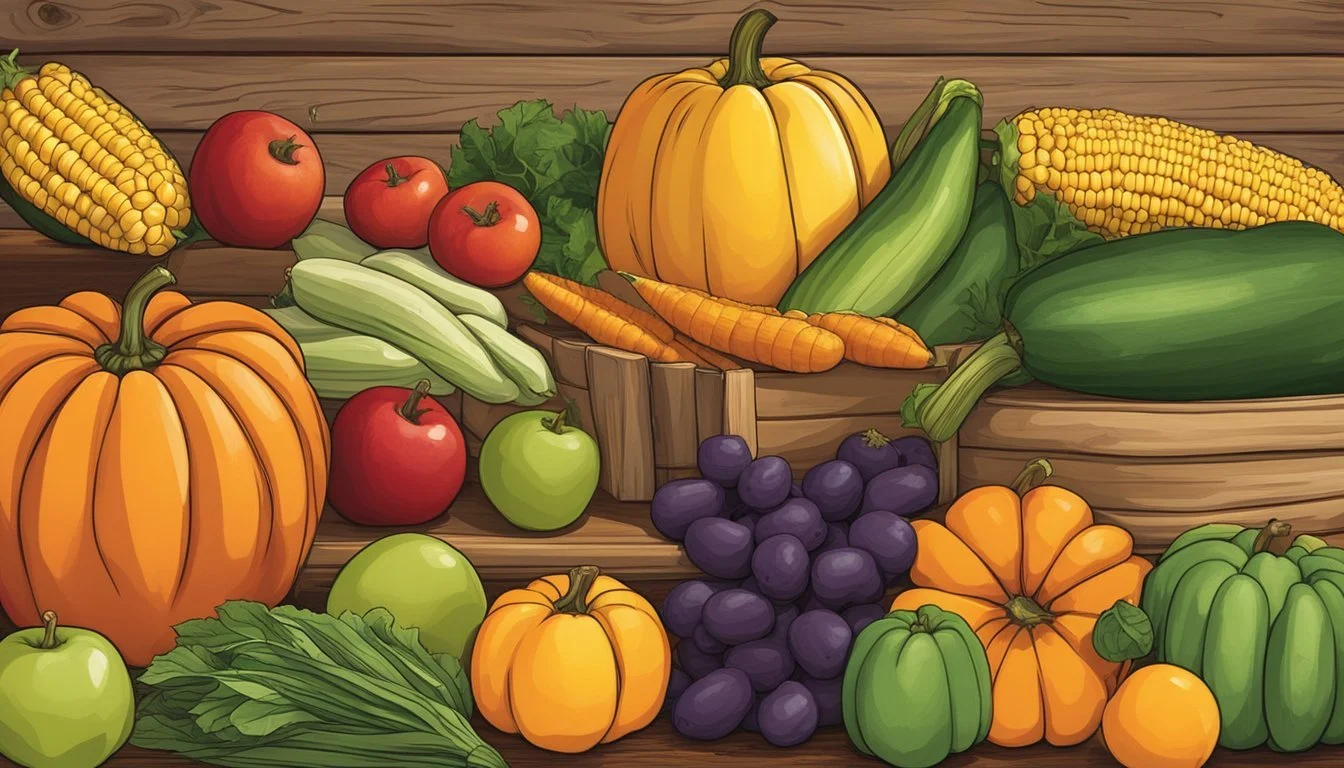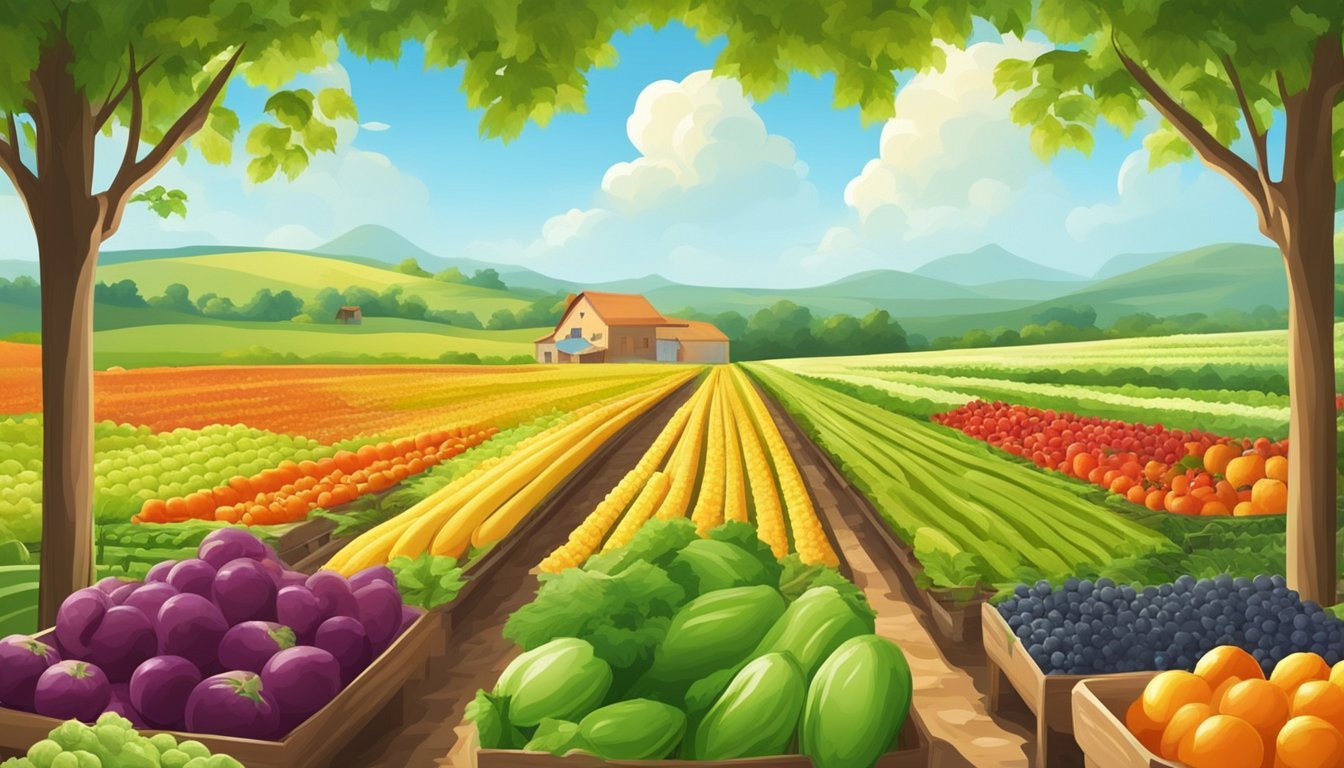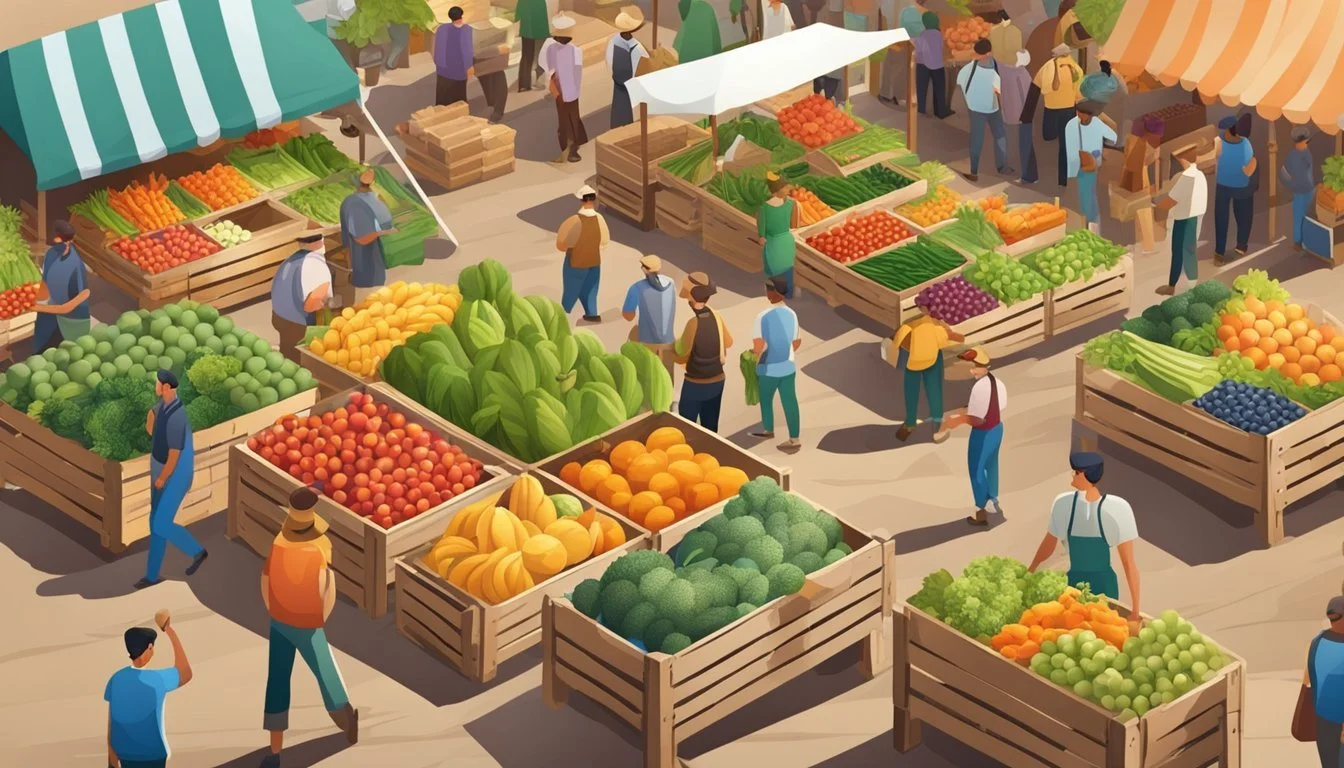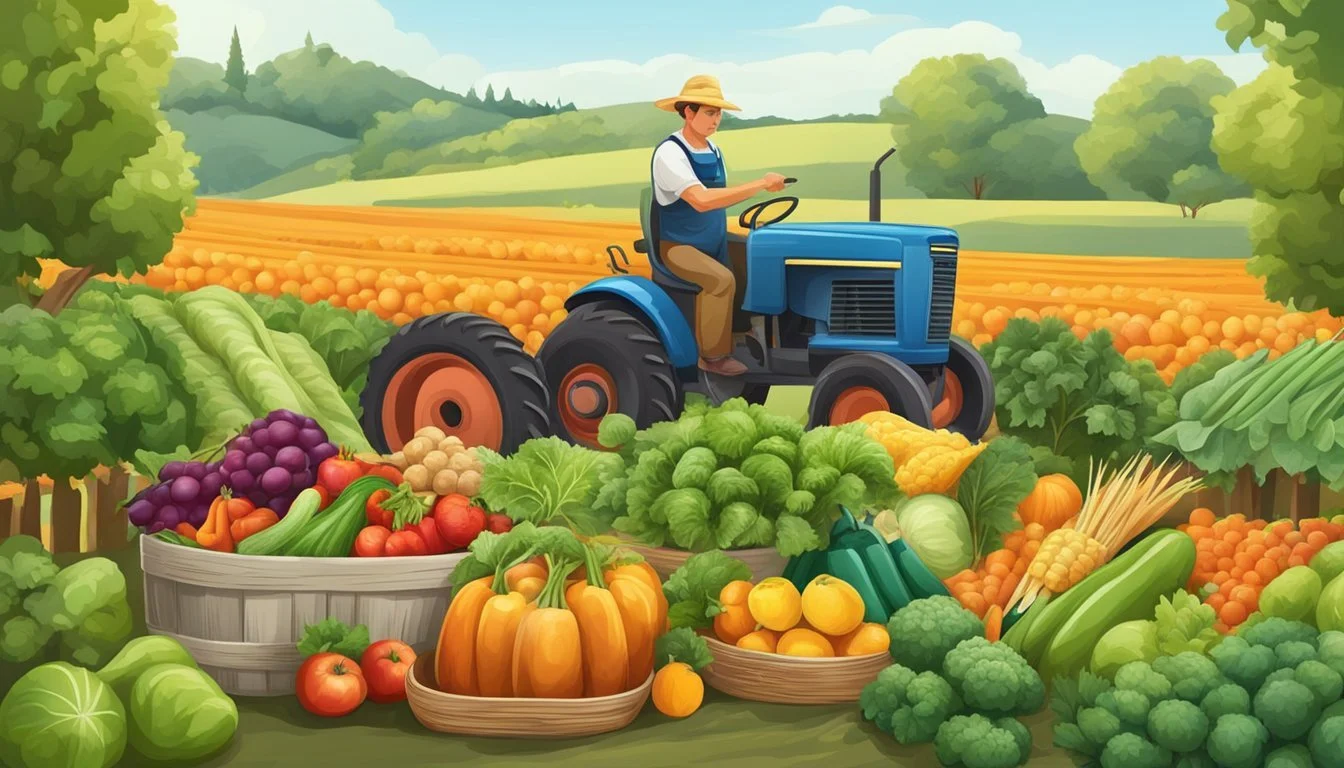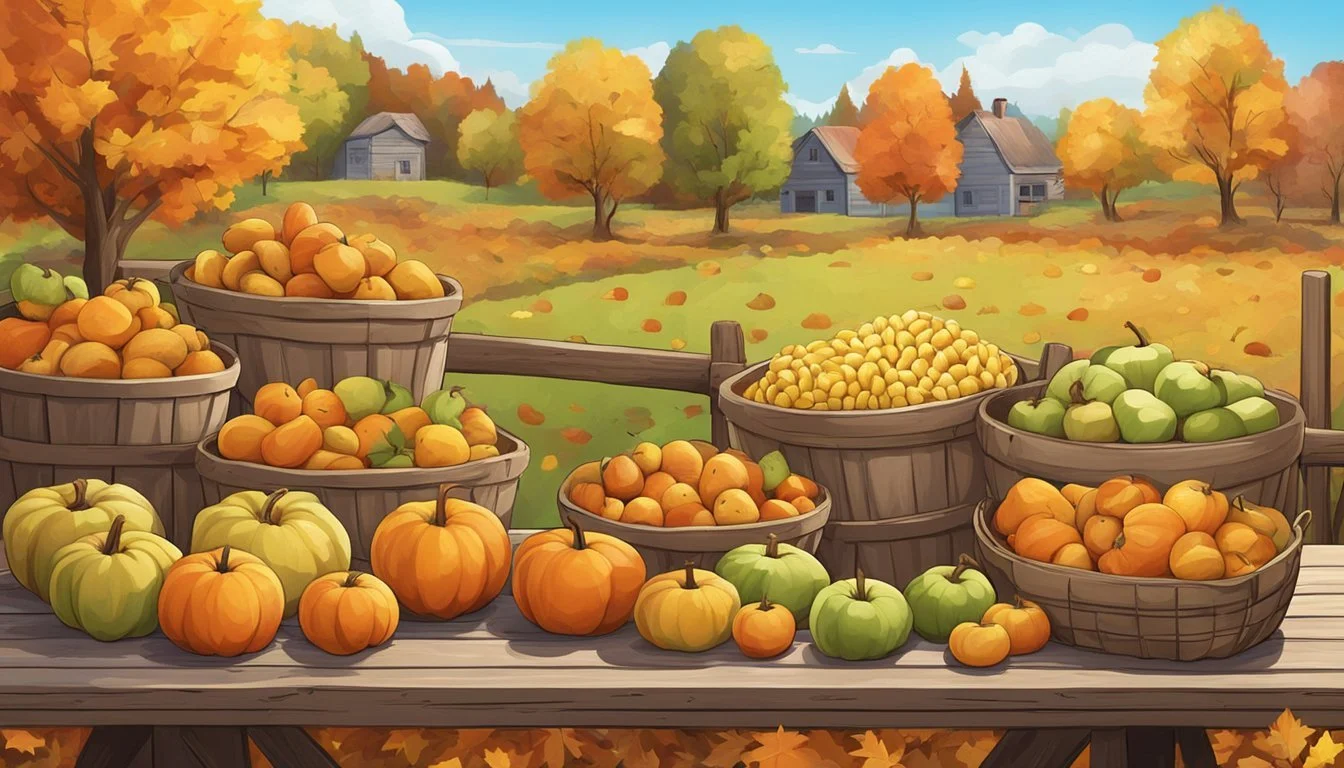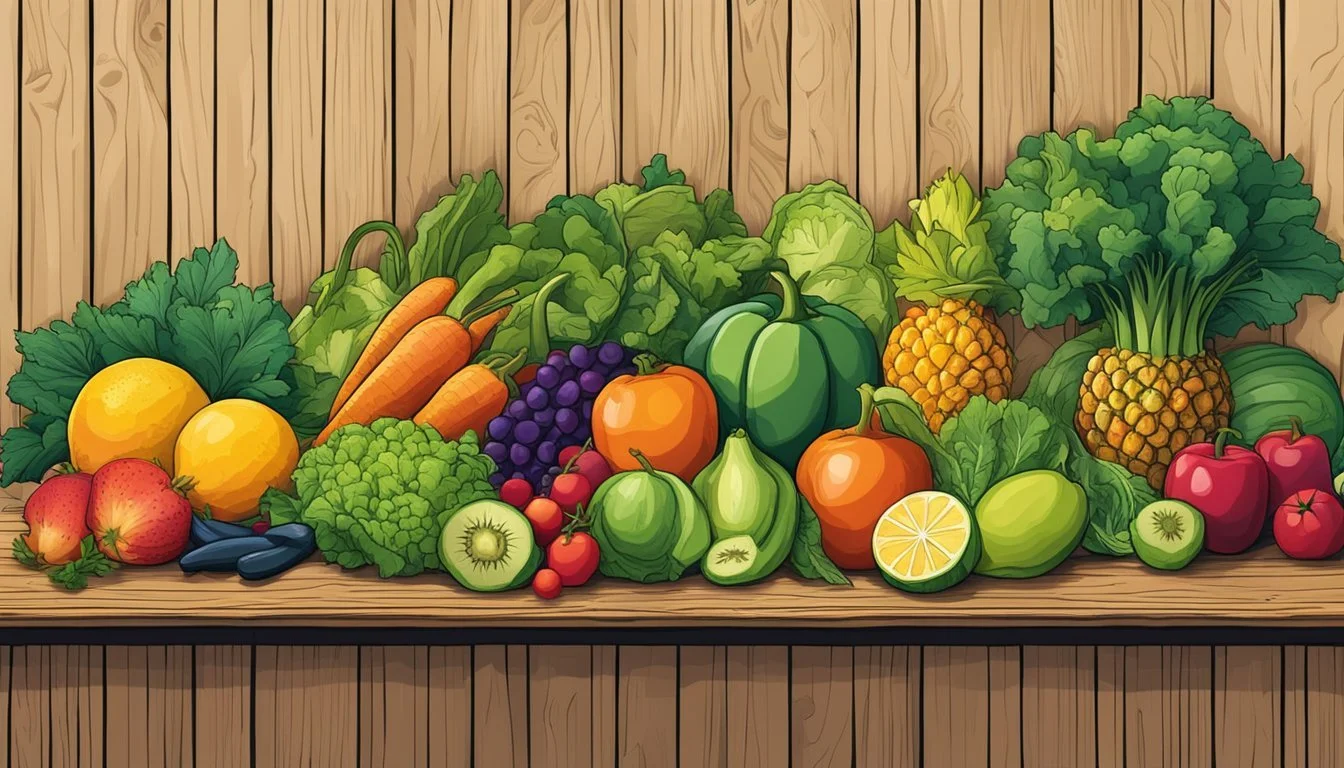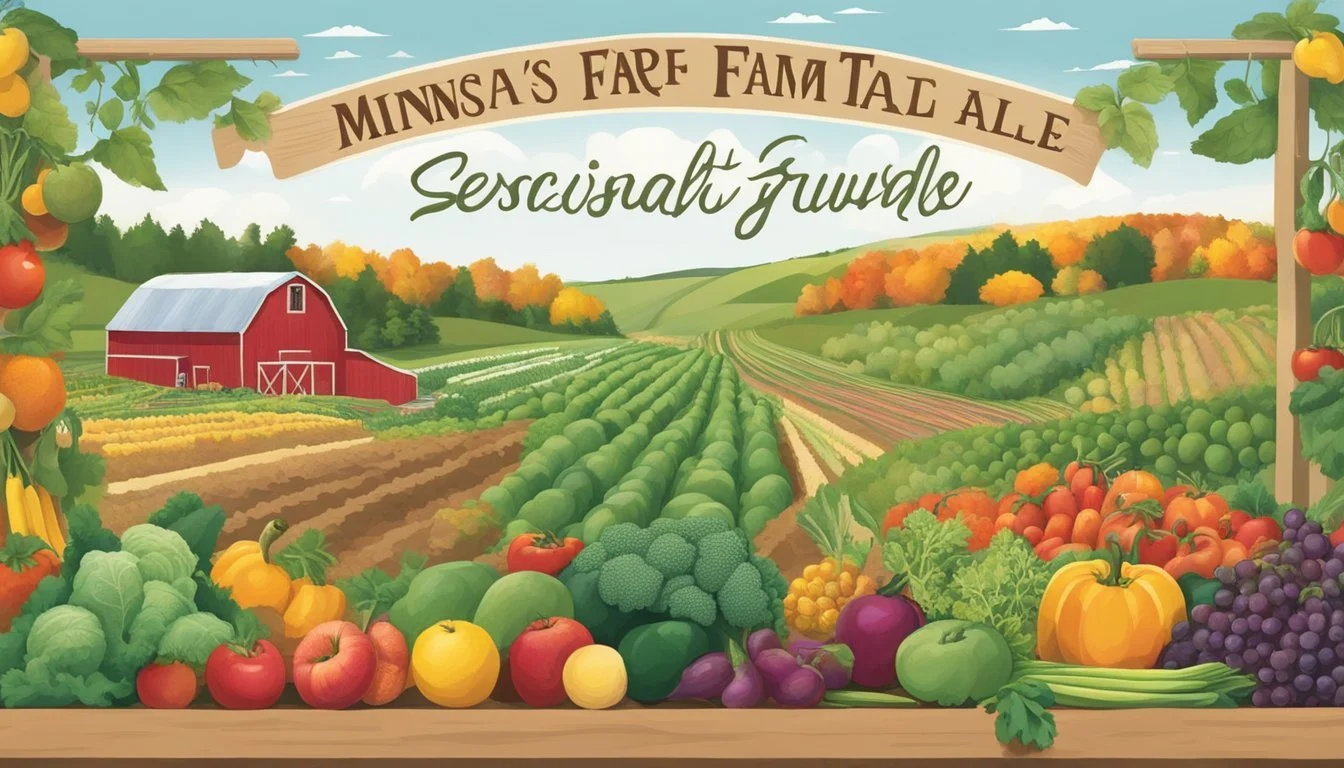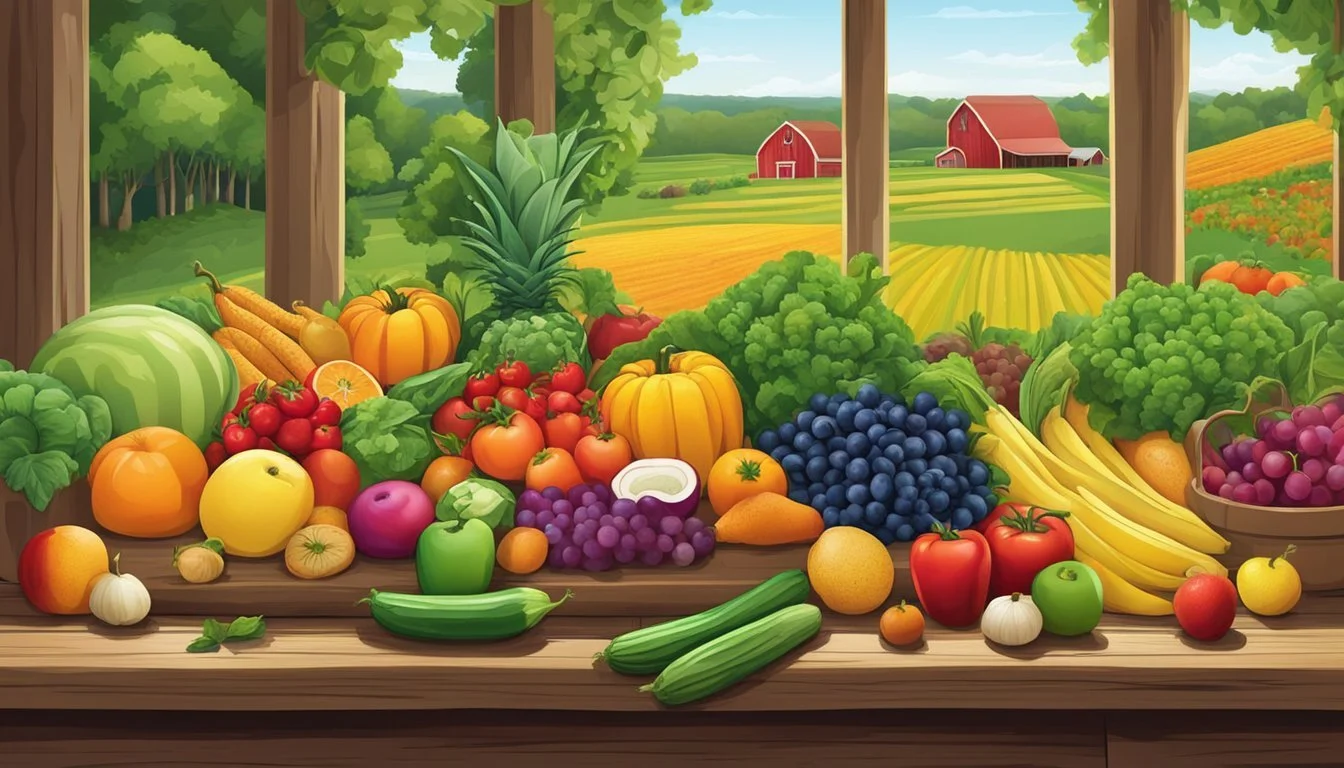Minnesota Seasonal Fruit & Veg Guide
Your Year-Round Companion
Embracing the farm-to-table movement, Minnesota offers a bountiful array of fruits and vegetables that vary with the seasons. As the seasons turn, so does the produce wheel, ensuring that what lands on the table is not only fresh but also has a lower carbon footprint and supports the local economy. With a climate that favors cool-weather crops, Minnesota’s harvest calendar guides residents and chefs alike in making the most of the state's agricultural offerings.
From the tender spears of asparagus (how long does asparagus last?) in spring to the heartiness of root vegetables in the fall, each season in Minnesota comes with its signature crops. Summertime ushers in a vibrant selection of berries, stone fruits, and leafy greens, while the autumn harvest is rich with pumpkins, apples (how long do apples last?), and a variety of squashes. This cyclical variety enables Minnesotans to experience a connection to their food and the land throughout the year.
Local farmers and markets are at the heart of the farm-to-table concept, providing Minnesotans with produce at the peak of freshness and nutritional value. The state's growing season may be shorter compared to more temperate regions, but the commitment to sustainable and local agriculture makes Minnesota a unique model for seasonal eating. The cold winters lead to a reliance on preserved goods and innovative greenhouse farming, ensuring that even in the harshest conditions, the connection between farm and table remains strong.
What’s in Season in Minnesota Right Now?
Understanding Minnesota's Seasons
Minnesota's agricultural calendar is distinctly shaped by its four seasons, each bringing its unique growing conditions and produce. Weather patterns play a critical role in determining the viability and seasonality of the fruits and vegetables grown in the region.
Winter Overview
In winter, Minnesota experiences cold temperatures and snow, with the growing season at a standstill. This period sees storage crops and preserved foods taking the stage, as fresh produce is limited. Root vegetables such as potatoes and carrots stored from fall harvests, along with preserved fruits and vegetables, are commonly used.
Spring Awakening
With the spring thaw, Minnesota begins a period of rejuvenation. Asparagus and green onions often lead as some of the first crops of the season in late May. Farmers prepare the soil, and seeds sown in late winter begin to sprout. By June, a broader variety of produce, including radishes and spinach, starts to appear.
Summer Abundance
The warm, humid summer months in Minnesota bring about a prolific growing season. From July to September, the state enjoys a bounty of fresh produce. This is the peak season for a range of fruits and vegetables:
Tomatoes
Sweet corn
Cucumbers
Berries (like strawberries and blueberries)
Stone fruits such as peaches and nectarines
Local markets are abundant with fresh, flavorful options.
Fall Harvest
As temperatures cool, Minnesota enters its harvest season. Starting in August and stretching into October, a colorful array of produce becomes available:
Apples: August through October
Squashes and pumpkins: typically peak in September and October
Root vegetables return to prominence
The fall harvest is a critical time for farmers to gather crops before the first frost and is celebrated in communities across the state.
Seasonal Produce Guide
Minnesota's diverse climate influences the availability of fresh produce throughout the year, emphasizing the importance of seasonality in farm-to-table eating.
Winter Selections
During Minnesota's cold winters, the selection of fresh, local produce narrows considerably. Hardy vegetables that store well dominate:
Root vegetables like beets and carrots
Storage crops such as onions and potatoes
Squash varieties capable of withstanding storage
Spring Offerings
In spring, Minnesotans welcome a wider variety of vegetables as the ground thaws:
Early greens like spinach and lettuce signal the start of the fresh produce season
Asparagus and rhubarb often lead as some of the first fresh produce to harvest
Summer Harvest
Summer in Minnesota offers an abundance of fruits and vegetables, marking the peak of harvest:
Berries (strawberries, blueberries) thrive in the early summer warmth
Tomatoes, green beans, peppers, and sweet corn become available as the season progresses
Autumn Choices
As the cooler weather of autumn sets in, the harvest shifts toward produce that fares well in fall conditions:
Root vegetables like beets and turnips
Apples, which reach peak ripeness in early fall
Pumpkins and gourds, emblematic of the season
Key Vegetables and Their Seasons
In Minnesota, the climate dictates a vibrant variety of vegetables that are harvested throughout the changing seasons. Farmers markets and local food co-ops become showcases for the freshest produce available during their specific peak periods.
Root Vegetables
Root vegetables thrive in the cooler temperatures of Minnesota's spring and fall. They include nutrient-dense options like carrots, which are usually at their peak from June through October, and potatoes, a staple that can be harvested from August to October. Onions have a broad season, ranging from summer into fall, while parsnips are best from September through November, gaining sweetness after the first frost.
Onions: May – October
Potatoes: August – October
Carrots: June – October
Parsnips: September – November
Leafy Greens
Leafy greens such as kale and chard flourish in Minnesota's cooler weather. Kale is typically harvested from June through the first hard frost, maintaining its quality even as it gets colder. Chard follows a similar timeline, with its season running roughly from June to October.
Kale: June – First hard frost
Chard: June – October
Seasonal Nightshades
Nightshades like tomatoes and peppers are summer crops in Minnesota, with the ideal time to enjoy them being July through September, depending on the specific variety. These vegetables require warmth and are sensitive to frost, making timing essential for their harvest.
Tomatoes: July – September
Peppers: July – September
Legumes and Gourds
Legumes, including peas and beans, have a relatively short season in Minnesota, mostly throughout the month of June, while gourds such as cucumbers start to come in around July and are often harvested into September. Gourds, mainly warm-season crops, are best planted after the danger of frost has passed.
Peas: June
Beans: June
Cucumbers: July – September
Seasonal Fruit Rhythms
Minnesota offers a rich tapestry of fruits which follow unique rhythms throughout the year, emphasizing seasonality to ensure freshness and support local farming.
Berries and Soft Fruits
In Minnesota, berries are celebrated as summer's sweet jewels, with strawberries appearing as early as June. As the summer progresses, raspberries and blueberries reach their peak ripeness, often through July and into August. Consumers and chefs eagerly anticipate the arrival of these fruits as they are not only bursting with flavor but also packed with nutrients.
Strawberries: June to early July
Raspberries: July to August
Blueberries: July to August
Tree Fruits
Apples are the quintessential Minnesota tree fruit, with a variety that grows well in the state's soil and climate. From late summer into fall, apples dominate the local market, providing an array of varieties from sweet to tart. Late summer also ushers in plums and pears, which have a shorter season but are equally treasured.
Apples: August to November
Melons
The warm summer months in Minnesota are ideal for growing a selection of melons. Cantaloupe (how long does cantaloupe last?) and watermelon are among the favorites, ripening in the hot July sun and continuing to be available through September. These melons are often a centerpiece at farmers' markets and local food establishments.
Cantaloupe: July to September
Watermelon: July to September
Minnesota's Unique Crops
In the diverse agricultural landscape of Minnesota, several crops stand out for their adaptation to the local climate and their significance in farm-to-table practices. These unique crops contribute to both traditional and specialty cuisines, reflecting Minnesota's rich agricultural heritage.
Grains and Staples
Minnesota farmers produce a variety of grains and staples that support both local consumption and contribute to the state's economy. The cultivation of corn, especially sweet corn, is prominent due to its versatility and the favorable Midwestern climate. In addition to corn, Minnesota is known for its production of wild rice (how long does wild rice last?), a staple grain traditionally harvested by the Native American Ojibwe and now a sought-after commodity for its nutty flavor and nutritional value.
Herbs and Specialty
The state's summer and fall months offer optimal conditions for a bountiful harvest of tomatoes, beans, and peppers. These crops are staples for Minnesotan farmers, with each variety presenting its own distinctive taste and culinary applications. Locally grown herbs, such as basil and dill, complement these vegetables and are often found fresh in farmers' markets, enhancing the flavors of Minnesota's seasonal dishes. Squashes, including varieties like butternut, acorn, and pumpkin, also thrive in the region's soil, adding sweetness and depth to the state's farm-to-table fare.
Local Marketplaces and Distribution
Minnesota's commitment to farm-to-table practices is evident through the vibrant local marketplace, which includes a network of farmers markets, roadside stands, and restaurant supply chains that champion local ingredients.
Farmers Markets Overview
Farmers markets across Minnesota provide consumers with direct access to fresh, seasonal produce and other local foods. In the Twin Cities metro area, markets are well-attended community hubs where local farmers bring the bounty of their fields, including fruits and vegetables, to sell directly to the public. Markets along Lake Superior's shores also offer a variety of goods, ensuring access to farm-fresh produce throughout the United States.
Roadside Stands and Small Shops
Roadside stands and small shops are a key component of Minnesota's local distribution. Such setups, often characterized by their familiar yellow and red gazebos, enable farms like Untiedt's Vegetable Farm to sell their fresh produce directly to passing customers. These points of sale offer a more intimate shopping experience and play a crucial role in supporting the local food economy.
Restaurant Supply Chains
Restaurants throughout Minnesota increasingly source their ingredients locally, strengthening the farm-to-table movement within the state's food scene. This includes forging partnerships with local growers to supply fresh, Minnesota-grown ingredients, thus supporting local economies and reducing the environmental impact of long-distance food transport. This direct relationship between farms and kitchens ensures that diners at these establishments enjoy the freshest seasonal offerings.
Farming and Harvest Practices
In Minnesota, farming and harvest practices prioritize sustainability and environmental stewardship. Farmers adopt specific techniques to meet the demands of agriculture while adhering to organic and sustainable principles, ensuring the delivery of high-quality seasonal crops.
Sustainable Agriculture
Farmers in Minnesota implement sustainable agricultural practices to preserve the environment and enhance soil health. These practices include crop rotation, cover cropping, and reduced tillage. Crop rotation is crucial as it helps prevent soil depletion, managing pests, and reducing the spread of diseases. Cover crops like rye or clover maintain soil structure and fertility, while reduced tillage lessens soil erosion and disruption.
Organic Farming
Organic farming in the state follows rigorous standards to guarantee the absence of synthetic pesticides and fertilizers. Producers focus on natural methods, such as using compost for soil enrichment and beneficial insects for pest control. These organic methods ensure farms can maintain their claims of producing clean, chemical-free fruits and vegetables.
Seasonal Harvest Techniques
Understanding seasonal harvest techniques is essential to Minnesota's agriculture sector. Farmers use specialized knowledge to determine the optimal times for harvesting different crops, such as apples, berries, and leafy greens. For instance, harvesting can occur in stages:
Apples: Selective picking based on ripeness to extend the selling period
Berries: Often hand-picked to maintain fruit integrity
Leafy Greens: Cut in the cooler parts of the day to prevent wilting
These harvest techniques ensure the produce retains maximum freshness and nutritional value from farm to table.
Business and Economics of Farming
In Minnesota, the farming sector merges traditional practices with economic strategies to sustain and grow. This section addresses the business aspects across small farm operations, commercial agriculture, and varying business models for local and export markets.
Small Farm Operations
Small farms in Minnesota often operate as diversified entities, blending crop production with dairy farming to maximize income and mitigate risks. They focus on direct-to-consumer sales, including community-supported agriculture (CSA) programs, farmers' markets, and farm-to-table initiatives. Financial management resources, like those from the Center for Farm Financial Management (CFFM), aid these farmers in navigating the fiscal challenges unique to small-scale operations.
Economic Impact: Small farms contribute significantly by supporting the local economy and preserving rural livelihoods. They typically emphasize sustainability and community involvement, which adds to their appeal for consumers looking for locally-sourced food.
Commercial Agriculture
Large-scale commercial agriculture represents a substantial portion of Minnesota's agricultural output. These operations tend to require more significant capital investment and advanced technology to achieve economies of scale. They are instrumental in producing the state's staple crops like corn and soybeans, (how long do soybeans last?) as well as dairy products.
Profitability Metrics: Commercial farms rely on financial benchmarks and economic assessments to gauge their performance and stay competitive both nationally and internationally.
Local and Export Business Models
Minnesota farms employ a variety of business models tailored to address either local or export demands. Local business models prioritize short supply chains and aim to strengthen the community's food autonomy. Conversely, export-oriented models cater to a global market, maximizing profits through large-volume sales.
Diversity of Operations:
Local: Utilizes farm-to-table systems, seasonal guides, and local partnerships to enhance market presence.
Export: Focuses on commodity crops and dairy products with an infrastructure supportive of large-scale distribution.
Both models require astute business planning and a clear understanding of market dynamics to succeed. Wealthier, well-established farms often have greater access to markets and technology, which allows them to adapt and thrive in various economic conditions.
Community and Culture
Minnesota's farm to table scene is more than a trend; it's embedded in the community's culture. Emphasizing local produce, the movement strengthens community bonds and celebrates Minnesota’s agricultural heritage.
Farm to Table Movement
The farm to table movement in Minnesota has cultivated a strong community ethos around local, seasonal eating. Restaurants and consumers alike value the connection to their food sources, often highlighting these partnerships on menus and in social media posts, with platforms like Facebook serving as a bridge to share stories and origins of the local fare. The emphasis is on the freshest and most flavorful produce, picked at its peak, which supports local farmers and minimizes the environmental impact of transportation.
Farmers markets are a staple, with vendors offering a cornucopia of fruits and vegetables that reflect the state's harvest calendar. From asparagus in May to pumpkins in October, Minnesotans rally around the freshest ingredients for their cuisine.
Agricultural Fairs and Events
Agricultural fairs and events are cultural touchstones in Minnesota, providing a venue for farmers to showcase their produce and for the community to engage with the people who grow their food. The iconic Minnesota State Fair, for example, is not only a showcase for farming and livestock but a celebration of the state's agricultural diversity and innovation.
Throughout the year, smaller events and festivals offer equally important opportunities for farmers and artisans to connect with locals and visitors. Events may feature cooking demonstrations, taste-testing new varieties of fruits and vegetables, and educational sessions on sustainable practices, all of which foster a deeper appreciation for Minnesota's rich farming culture.
Produce Preparation and Preservation
Preserving fresh produce at its peak not only extends the season’s bounty but also provides delightful flavors year-round. Minnesota's diverse range of fruits and vegetables can be maintained through canning, pickling, and drying, each method offering its own advantages for long-term storage and enjoyment.
Canning and Pickling
For those looking to preserve the taste of Minnesota's seasonal produce, canning is a popular method. Fruits commonly canned include strawberries for jams and tomatoes for sauces. Vegetables such as cucumbers are often pickled, providing a tangy and crisp snack. Proper sterilization and sealing are essential steps in the canning process to ensure safety and quality.
Fruit Canning:
Vegetable Pickling:
Cucumber Pickles
Beetroot
Drying and Storage
Drying fruits and vegetables is an age-old preservation technique that removes moisture to prevent spoilage, concentrating the flavors and making the produce ideal for storage. For example, dried strawberries (how long do dried strawberries last?) can be a sweet, chewy snack or a handy addition to granolas and cereals.
Dried Produce:
Strawberries
Apples
When drying or storing produce, ensuring that all items are completely dry and stored in a cool, dark place helps in prolonging their shelf life and maintaining their taste and nutritional value.
Additional Farm Products
Beyond the seasonal bounty of fruits and vegetables, Minnesota's farms offer a rich variety of other fresh products. These include dairy, eggs, and a selection of meats and specialty items that reflect the state's agricultural diversity and commitment to quality.
Dairy and Eggs
Minnesota farms provide a range of dairy products, including fresh milk, cheeses, and yogurt. The state's dairies are known for their quality control and pasture-raised cattle, which contribute to the superior taste and nutritional value of their products. Consumers can find artisan and farmstead cheeses, showcasing the skill of local cheesemakers.
Milk Products:
Fresh milk
Cheese varieties
Yogurt
Eggs: Farms across the state offer fresh, free-range eggs.
Known for their rich flavor and deep-colored yolks, these eggs are a staple in local kitchens and restaurants.
Meats and Poultry
The meat selection from Minnesota farms includes beef, pork, lamb, and a variety of poultry. These animals are often raised on a diet free from unnecessary antibiotics and growth hormones, ensuring the quality of the meat.
Meats:
Beef
Pork
Lamb
Poultry:
Chickens
Turkeys
Local Specialty Items
Minnesota’s farms produce several specialty items that are unique to the region. Honey is one such product, with local beekeepers managing hives that contribute to the pollination of crops and wild plants alike, resulting in high-quality, flavorful honey.
Honey: Available from local beekeepers, it comes in various flavors based on the flora the bees have pollinated.
Artisan Cheeses: There is a growing market for locally produced, handcrafted cheeses which are often made from the milk of grass-fed animals.
Minnesota’s local farms offer freshness and quality not only in fruits and vegetables but also in numerous other farm products, including dairy, eggs, meats, and specialty items. These products are integral to the state's farm-to-table philosophy, enhancing Minnesota's culinary landscape.
Health and Nutrition
Focusing on health and nutrition, one finds a wealth of advantages associated with incorporating local and seasonal fruits and vegetables into their diet. The natural cycle of produce is perfectly designed to support our nutritional needs.
Benefits of Seasonal Eating
Seasonal fruits and vegetables grown in Minnesota offer peak nutritional value when harvested at the right time. They are richer in vitamins, minerals, and antioxidants. Eating these foods soon after harvest means they retain more of their nutritional profile, as opposed to produce that has been stored or transported over long distances.
Health: Seasonal produce tends to be fresher and full of flavor, encouraging a higher intake of fruits and vegetables. This can lead to a diverse diet rich in essential nutrients, supporting overall health, and well-being.
Local Ingredients: Locally sourced ingredients support the community's economy and reduce the environmental impact of transportation. They also tend to be more sustainable, with less packaging and reduced storage needs.
Table 1: Nutrients Found in Seasonal Minnesota Produce
Season Produce Nutrients Spring Rhubarb Fiber, Vitamin C, Calcium Summer Strawberries Vitamin C, Manganese, Folic Acid Fall Sweet Corn Vitamin B6, Fiber, Magnesium
Consuming local, seasonal produce not only nurtures one's body with essential nutrients but also promotes a sustainable lifestyle, which contributes to long-term health benefits for consumers and the environment alike.
Agricultural Policies and Regulations
In Minnesota, agricultural policies and regulations form a framework that ensures the safety and quality of locally sourced farm-to-table fruits and vegetables. They govern various aspects of agriculture from farm operations to consumer protection.
Crop Claims and Certifications
Claims: Minnesota's Department of Agriculture requires that all claims made regarding crops, such as organic or non-GMO, adhere strictly to state and federal regulations. Certifications must be verifiable and compliant with the United States Department of Agriculture (USDA) standards.
Antibiotics: While antibiotics are not typically a concern with fruit and vegetable farming, the state mandates that any use of such substances in agricultural practices must be reported and regulated to avoid mislabeling and to safeguard public health.
Farming Subsidies
Farming subsidies in the United States may be available to Minnesota farmers, including those growing fruits and vegetables. Subsidies are tied to precise regulations designed to support fair competition, sustainable practices, and market stability across the agricultural sector.
Minnesota's subsidy programs often focus on aiding farmers in times of market disruption and providing financial assistance for adopting innovative farming practices.
Supporting Minnesota Agriculture
The vitality of Minnesota agriculture is fortified by consumer participation, community engagement, and strong educational programs. These pillars serve as conduits between the state's growers and the wider public, ensuring the sustainability and success of local farming.
Consumer Choices
In Minnesota, individuals have the power to directly support local agriculture through their purchasing decisions. Opting for locally grown produce at farmers' markets, subscribing to Community Supported Agriculture (CSA) boxes, and prioritizing seasonal fruits and vegetables at grocery stores can significantly bolster the earnings of local farmers.
Farmers' Markets: Regular attendance and purchases at these markets sustain farmers' livelihoods.
CSA Subscriptions: These ensure a steady income for growers and provide consumers with fresh, seasonal produce.
Seasonal Shopping: Consumers who focus on seasonal produce help stabilize demand and support agricultural planning.
Community Engagement
Community involvement plays a critical role in upholding the fabric of Minnesota's agricultural framework. Through participation in agriculture-focused events such as the annual Women in Ag Conference, communities stay connected with the challenges and advancements of local growers. Support mechanisms like the Minnesota Fruit and Vegetable Growers Association (MFVGA) also foster a sense of unity and collaborative growth among farmers.
Agricultural Events: They facilitate knowledge exchange and networking among the agricultural community.
Organizations: Groups like MFVGA advocate for farmers' interests and provide a platform for collective action.
Educational Programs
The University of Minnesota Extension is a testament to the state's commitment to agricultural education and support. By providing resources on integrated pest management, growing guides, and greenhouse management, the university equips local fruit and vegetable producers with the skills to thrive. These educational efforts contribute to the overall food security and economic stability of the region.
Growing Guides: These aid farmers in producing high yields of quality produce.
Pest Management: Education on pest management helps protect crops and ensures sustainable growing practices.
In essence, Minnesota's agricultural health is underpinned by the active involvement and education of both its producers and consumers, establishing a robust, connected community.



